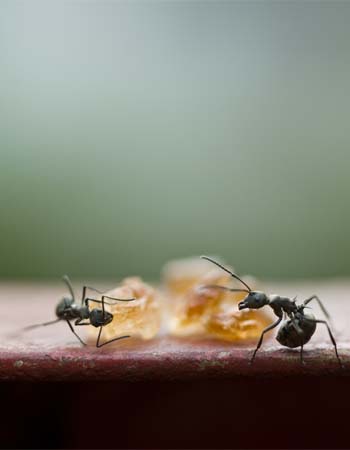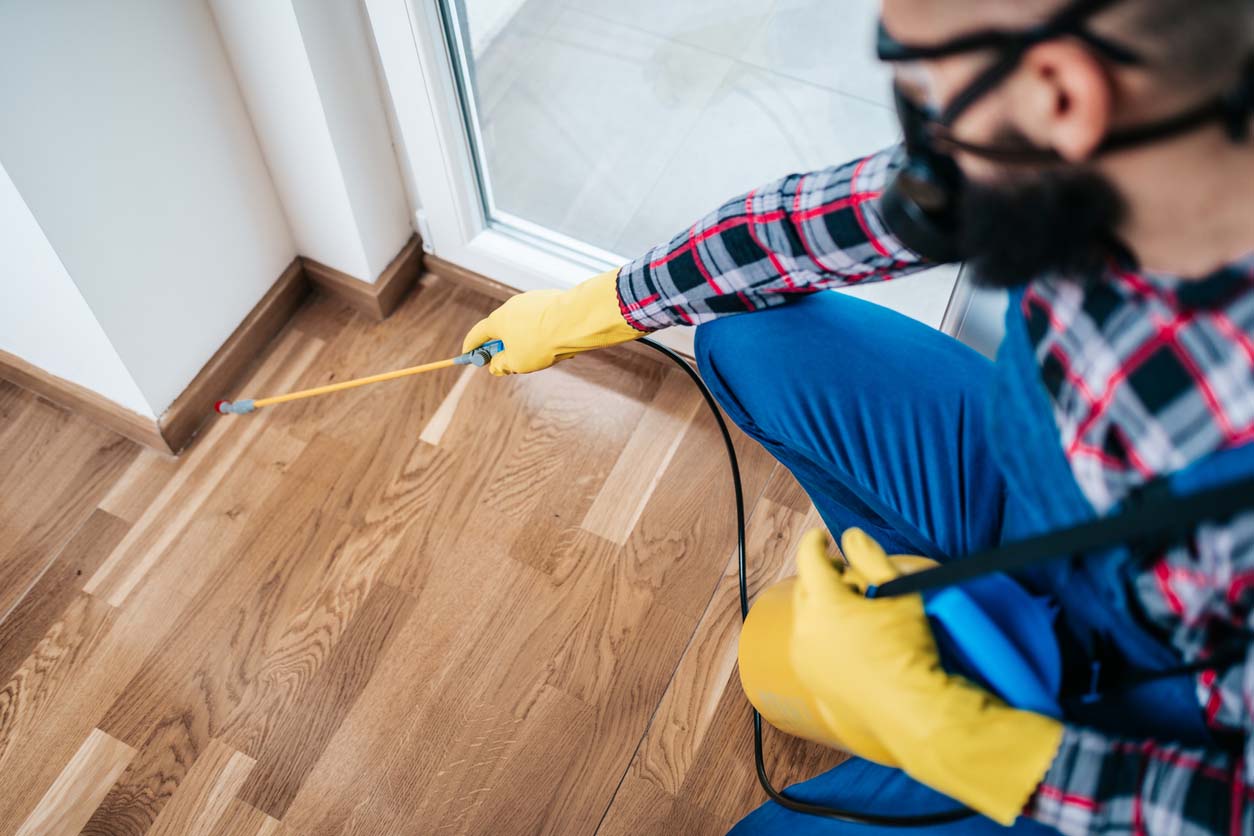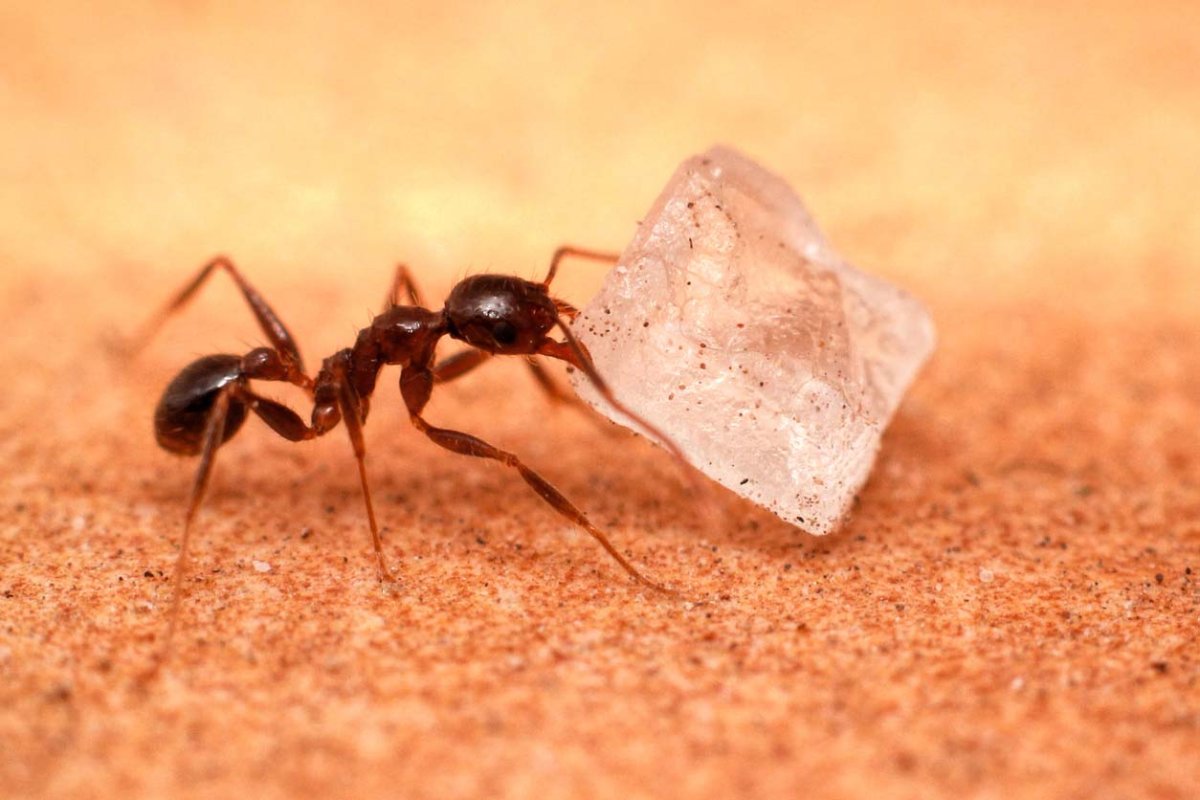We may earn revenue from the products available on this page and participate in affiliate programs. Learn More ›
Humans aren’t the only ones who enjoy the sweet taste of sugar. Many people head into their kitchens only to be greeted by a swarm of sugar ants taking over a sweet treat or sticky spill on the countertop. While sugar ants are not inherently dangerous, they are generally unwelcome inside the home. Fortunately, there are plenty of solutions available for those struggling with how to get rid of sugar ants in the house.
Time required: Dependent on the size of the infestation; as little as 48 hours or as long as 3 weeks
Difficulty: Beginner
Estimated cost: $10 to $30 for home treatment; or $80 to $500 for professional intervention
Tools & Materials
Bobvila.com may earn a commission from purchases made through these links.
- Food storage containers
- Multipurpose cleaner
- White vinegar (optional)
- Lavender essential oil (optional)
- Peppermint essential oil (optional)Diatomaceous earth (optional)
- Caulk or spackle
- House paint (optional)
- Syrup (optional)
- Honey (optional)
- Boric acid (optional)
- Shortening (optional)
What are sugar ants?
“Technically there is no ant that is officially named a sugar ant,” explains Craig Sansig, service director at Liberty Corner, New Jersey–based Viking Pest Control. “More correctly, they are a group of ants that may prefer sweets in their diet and enter homes. ‘Sugar ants’ is a catchall phrase for all small peridomestic ant species.”
In North America, the ant colloquially called the “sugar ant” is also known as the odorous house ant. True to their name, sugar ants enjoy eating sweets as well as fats, pollen, and insects. While these small ants aren’t dangerous and will not bite or sting, they can quickly become a nuisance as their population within a home grows.
“There are numerous small species of ant depending on where you are in the country,” says Sansig. “These include pavement ants, odorous house ants, Argentine ants, little black ants, crazy ants, and ghost ants. [The] name sugar ant is used because all species are attracted [to] and will readily consume carbohydrates like sugar.”

How to Identify Sugar Ants
Odorous house ants are black or brown in color and have 12 distinct antennae segments. They are also one of the smallest types of ants, measuring between 2.5 and 3 millimeters (around 1/10th of an inch) in length. As the name implies, this species’ most distinguishing characteristic is its odor. When crushed, it releases a smell akin to a rotten coconut. In addition to these distinct characteristics, sugar ants can also often be identified by their behavior. Homeowners can typically find tiny sugar ants in the kitchen or around open food, especially sweet and sticky substances.
Brown or black sugar ants can be easily confused with pavement ants, which are also small, black or brown insects. However, pavement ants can run slightly larger, between 2.5 millimeters and 4.2 millimeters (approximately 1/10th to 1/6th of an inch). They also have pale legs, dual spines, and small stiff hairs all over their bodies. Though pavement ants may also show up in kitchens looking for grease spots, they are most commonly found in sidewalk cracks.
In short, some signs of sugar ants in a home include:
- A collection of small black or brown insects gathered near an open food source.
- A trail of small black or brown insects leading toward food crumbs or spills.
- A rotten coconut odor (if the ants have been crushed).
Tips for Getting Rid of Sugar Ants
- Understanding what attracts ants—and how they gain access to a home in the first place—can help reduce the likelihood of a sugar ant infestation. What works for getting rid of fire ants may not be as effective for sugar ants since they are attracted to different food sources.
- In the event of a significant infestation, or if natural ant control treatments have not been effective, it’s best to call in an exterminator.
Safety Considerations
- Sugar ants bite only in self-defense, and their bites do not typically cause symptoms in people (unless the recipient has significant allergies). If the bitten area is painful, another species of ant—such as a fire ant—may be the culprit.
- When using one of the best ant killers, it’s wise to research any environmental and health effects.
- Some ant killers are harmful to people and pets, while others can negatively impact local soil and water sources.
STEP 1: Seal any potential entry points to the home.
Ants can easily enter the home through the smallest of openings, including gaps in the foundation, cracks in the wall or flooring, and open windows or doors. Once inside the home, tiny, small ants can also make their way into small spaces in and around cabinets and drawers.
Small interior gaps, such as those around baseboards, can be sealed with caulk. For cracks in the exterior, including the house foundation, spackle can fill in the space. A coat of paint over the spackle, or any small cracks in the wall, can add further protection (and visual appeal).

STEP 2: Eliminate any open food sources.
After sealing any potential entryways into the home, it’s time to eliminate the sugar ants’ motivation to explore further by blocking any open food sources. The first step to get rid of ants in the kitchen is to transfer all foods to airtight containers to prevent ants from catching a whiff or getting to the source. Homeowners will want to clean any food spills, particularly sweet or sticky ones, immediately.
In addition to eliminating the food sources, it’s also important to keep any sugar-ant hotspots clean. Ants communicate via scent trails, which allow other ants to know where to search. Wiping down countertops with soapy water or cleaning spray removes any scent trails, which helps stop attracting other members of the colony.
STEP 3: Use bait traps to capture any ants.
Bait traps can be effective in luring and capturing ants. There are also plenty of store-bought sugar ant traps on the market, which can be placed in areas where ants have been seen. If using commercial ant traps or bait, it’s important to follow directions carefully and keep them out of reach of children and pets. It’s also a good idea to make sure the bait is designed for sugar ants. The best fire ant killers or pesticides designed for carpenter ants may not be effective against other ant types.
Several homemade ant traps that work for sugar ants also exist, which are simple to make and often safer than commercial options. These traps take advantage of sugar ants’ proclivity for sugary substances. One common sugar ant bait is honey or syrup mixed with boric acid—the acid is of low toxicity for humans and pets, but acts as a poison for sugar ants. For ants that seem to be drawn to greasy substances, mixing shortening, sugar, and borax can create an effective bait for sugar ants. What makes this ant home remedy especially effective is that borax is a relatively slow sugar ant killer, so they’ll live long enough to bring the poison back to the rest of the colony.
Sansig recommends tailoring the type of bait to the season. “Proteins are preferred in spring when egg production and larval development are at their peak,” he explains. “Carbohydrate-based baits are generally more attractive to ants in the summer due to the larger populations after spring colony growth.”
STEP 4: Try natural methods.
Aside from regularly cleaning up crumbs and spills around the home, there are a few effective natural home remedies for ants:
- White vinegar. A mixture of one part white vinegar to one part water can be sprayed near the ants’ entry point and trails, as well as any baseboards in between to effectively kill sugar ants. Ants are typically most active in the morning and late afternoon, so homeowners may wish to time their spraying to maximize the number of ants killed.
- Essential oils. A mixture of water with a few drops of essential oils like lavender and peppermint can also be an effective home remedy for ants and other insects when sprayed around the home (and may smell much better than a vinegar solution). Peppermint oil in particular is useful for getting rid of flying ants, spiders, mice, and more. “A group of plant essential oils exempt from registration by the EPA called 25(b) products are often very repellant and may be effective at repelling most ant species,” explains Sansig.
- Food-grade diatomaceous earth. Diatomaceous earth (DE) is a substance that is deadly to insects but non-toxic for humans and household pets. It is a fine white powder made from crushed marine phytoplankton that can be sprinkled along ant trails to destroy the ants’ digestive systems.
- Garlic. The scent of garlic has a way of overpowering other odors. Hanging up garlic bulbs in a pantry may mask the smell of sweets that would attract sugar ants, causing them to stay away.
- Used coffee grounds. Coffee’s strong acidic odor is repellent to sugar ants. Sprinkling used coffee grounds in places where ants are getting inside or congregating may cause them to relocate.
- Other foods with strong odors. Foods like cloves and bay leaves can deter sugar ants from their scent trail by confusing them. Spices can be set out on the counter to discourage sugar ants from gathering near any crumbs or spills.
STEP 5: Take measures to prevent future sugar ant infestations.
After doing the hard work of getting rid of sugar ants, it’s important to put measures in place to avoid finding tiny ants in the kitchen again. One simple method is staying on top of cleanup after preparing food—especially sweet or sugary foods. Wiping down counters, sweeping and mopping, and securing trash bags after cooking will do away with crumbs or odors that are tempting to sugar ants.
To prevent infestations, Sansig recommends starting with good sanitation. “Keep kitchen debris to a minimum,” he advises. “Ensure garbage areas are kept clear. Make sure leaky spigots are repaired, especially during prolonged periods of dry weather. Water is vital, and large numbers of ants will readily enter sink traps and toilets to retrieve it when it is scarce outdoors.”
Another option is tracking down places where ants can enter the home in the first place. Any cracks, gaps, or holes in the home’s exterior can be sealed with caulk. In fact, this is key to having a DIY pest-free home in general, as it can help keep out pests of all kinds.
“Utilize appropriate caulks and sealants to close gaps where ants may enter,” says Sansig. “Trim shrubs, trees, and plants so that they are not touching the home.”

STEP 6: Hire a professional to effectively eradicate sugar ants.
While home treatment for sugar ants can be effective for small or one-off instances, larger or ongoing infestations likely require professional intervention. An exterminator has extensive knowledge of how to kill sugar ants and other pests, as well as access to the most effective tools and treatments to eradicate them. A professional from one of the best pest control companies such as Terminix or Orkin can also provide insight into how to prevent any future infestations.
Hiring an ant exterminator costs anywhere from $80 to $500, but the average cost of sugar ant extermination in particular is $200 to $250. Exact rates will vary depending on geographic location and the extent of the infestation. Homeowners may also opt for ongoing treatments or maintenance services, which come at an additional cost, but may be well worth the peace of mind provided by an ant-free home.
By following the above guide, homeowners will be able to effectively identify sugar ants, as well as how and why they make their way in. They will also be equipped with the necessary tools and knowledge to eradicate sugar ants and prevent future infestations. When in doubt, hiring a professional exterminator can ensure a sugar ant population is eliminated.
FAQs
For those seeking additional information on getting rid of sugar ants, read on for answers to frequently asked questions.
Q. How do I get rid of sugar ants in a natural way?
Some natural home remedies for sugar ants include a water and white vinegar solution, water with some drops of lavender or peppermint oil, or food-grade diatomaceous earth (DE). You can also try other foods with strong odors, such as garlic, bay leaves, or used coffee grounds.
Q. What attracts sugar ants to my house?
Sugar ants have strong scent receptors and are attracted to the smell of food, especially sweets and meats. They typically build their nests in warm, moist locations; though sugar ants most often nest in kitchen cupboards and pantries, it’s not uncommon to find sugar ants in the bathroom.
Q. Will sugar ants bite me?
Sugar ants, like flying ants, are considered to be mild-mannered, as they bite only in self-defense and do not sting. Bites from a sugar ant do not hurt, nor do they cause any symptoms (unless the person has a severe allergy).
Q. What scent keeps sugar ants away?
Strong odors like peppermint oil, lemon juice, coffee grounds, whole cloves, and bay leaves repel sugar ants. And even though there’s a lot of differences between termites vs. ants, termites also hate these smells.
Q. Do sugar ants hate vinegar?
For those wanting ant repellents that are natural, vinegar is a top contender. Sugar ants (and ants in general) hate the smell of vinegar, which interferes with their scent trails. Rather than allow themselves to get lost in a location with vinegar, ants will typically attempt to leave the location of the odor.
Q. How long do sugar ants live on average?
The lifespan of a sugar ant depends on its role in the colony. Male sugar ants, responsible only for mating, live approximately 20 days, while worker sugar ants have a lifespan of up to 7 years. A queen sugar ant being taken care of by her subjects can live 10 to 15 years.
Q. Will sugar ants go away on their own?
Sugar ants are not likely to go away on their own. If home remedies for ants are not working, a pest control professional will know how to get rid of sugar ants for good.
Q. How do you find out where ants are coming from?
One effective way to find out where ants are coming from is to put out a bait trap in a conspicuous place. Once enough ants are attracted to the bait, a trail will form that leads back to the entry points. It may also be worth checking outdoor areas like wood or leaf piles or underneath siding for signs of ant activity.


